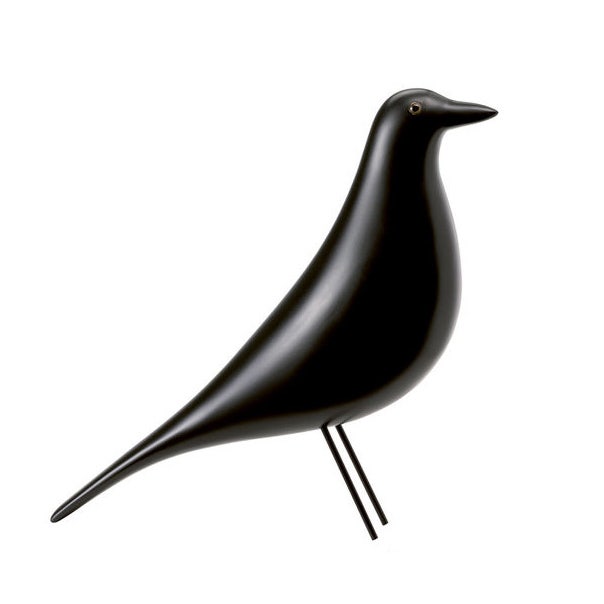Vitra Eames House Whale
Charles and Ray Eames surrounded themselves in their legendary Eames House with their own designs and an extensive collection of folk art, as well as other small objects found on their travels, in nature and in everyday life. Almost everything they collected was related to aspects of design and form, as Ray explained: 'We never collected anything just as collectors, but because something was inherent in the piece that made it seem like a good idea to be looking at.' The Eameses organized and decorated their living space with great seriousness and tremendous joy, making the Eames House an ever-changing collage, a reflection of their life.
A prominent feature of the Eames collection was a huge wooden whale over two metres in length, an anonymous work of North American folk art. Charles and Ray Eames were exceptionally fond of the painted object: it occupied a permanent place in the Eames Office and was also used in photo shoots – such as the first photos of the Lounge Chair. The smaller-scale reproduction of the Eames House Whale by Vitra is crafted from ash wood and painted by hand.
MEASUREMENTS:
- Height: 14 cm / 5.5 inch
- Length: 70 cm / 27.5 inch
MATERIALS:
- Solid Ash Wood, Hand-Painted

Charles and Ray Eames
USA
Charles, 1907 – 1978 / Ray, 1912-1988
The prolific body of work of Charles and Ray Eames, which spanned from 1941 to 1978, extended well beyond their major achievements in furniture design, graphic design, architecture and film. Their influence on the aesthetic and social aspects of design made them two of the greatest industrial designers of our time.
Born in St. Louis, Missouri, Charles Eames grew up in America’s industrial heartland. As a young man he worked for engineers and manufacturers, anticipating his lifelong interest in mechanics and the complex working of things. Ray Kaiser, born in Sacramento, California, spent her formative years in New York’s modern art movements and participated in the first wave of American-born abstract artists. They met at the Cranbrook Academy of Art near Detroit in 1940. Cranbrook’s creed of better living through better design shaped their sensibilities and their shared agenda. They married in 1941 and moved to Los Angeles as the city was gearing up for World War II. Wartime experiments with new materials and technologies inspired the Eames’ low-cost furniture for Herman Miller and expanded ways for designers to work with industry.
In LA, they conducted plywood experiments in their apartment. The US Navy order enabled the Eames to rent an office on Santa Monica Boulevard in 1942 and to gather a group of collaborators including Harry Bertoia. They produced sculpture, chairs, screens, and tables in plywood. Herman Miller, the US furniture group, was persuaded to put some of these pieces into production by George Nelson, its head of design. All the Eames’ plywood furniture combined an elegant organic aesthetic with a love of materials and technical ingenuity. After the success of the plywood pieces, the Eames focused on other materials, creating furniture in fiberglass, plastic, aluminum and, for the 1956 lounge chair, leather and rosewood. The Lounge Chair became an icon of the 1960s and 1970s, becoming a must-have for all hip executives.
Their collaboration with Herman Miller continued and extended to Vitra, its European partner. Charles and Ray were equally influential at making respectable the then-neglected folk crafts not only in the US but also in India. These concerns dominated their later work in the 1970s when, able to live comfortably on their Herman Miller and Vitra royalties, they concentrated their creative energy on propagating their ideas in exhibitions, books and films.
Charles died in 1978 and Ray worked hard to complete any unfinished projects but having done so, did not seek new ones. She devoted the rest of her life to communicating their ideas through talks and writing. Ray Eames died in 1988, ten years to the day after Charles.

Vitra is a Swiss company dedicated to improving the quality of homes, offices, and interior public spaces through the compelling power of design. Their chairs, tables, and accessories, including clocks, toolboxes, and cushions, are developed with an intensive, modern design process. Fusing engineering excellence with the creative genius of leading-edge international designers, Vitra enhances the aesthetic and emotional aspects of every space they grace.
All Vitra products are functional, inspiring, and durable. Founded in 1950, the family-owned Vitra line is designed and created by internationally recognized contemporary designers such as Verner Panton, Isamu Noguchi, Eero Saarinen, and Jasper Morrison. “We make products that avoid the superfluous and last for a very long time,” says Vitra chairman Rolf Fehlbaum.
This item qualifies for free door-to-door delivery within the Continental USA and Canada, with a few exceptions:
- Orders $180 or less are charged a $35 small order fee at checkout.
- Please contact us for a quote if you are located outside of the Continental USA.
- This is standard curbside delivery; meaning the driver will not haul up an incline or up stairs, and it will be your responsibility to bring the item inside, complete any assembly, and remove packaging debris.
- For a White Glove Delivery quote which includes unpackaging and assembly, please make a note in the Comments section during Checkout and we will get back to you as soon as possible.
For further information on our shipping policies click here.
For further information on returns + refunds click here.








